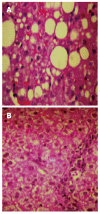Cardiovascular risk across the histological spectrum and the clinical manifestations of non-alcoholic fatty liver disease: An update
- PMID: 26078558
- PMCID: PMC4462722
- DOI: 10.3748/wjg.v21.i22.6820
Cardiovascular risk across the histological spectrum and the clinical manifestations of non-alcoholic fatty liver disease: An update
Abstract
Non-alcoholic fatty liver disease (NAFLD) is considered to be an independent cardiovascular disease (CVD) risk factor. However, simple steatosis has a benign clinical course without excess mortality. In contrast, the advanced form of NAFLD, non-alcoholic steatohepatitis (NASH) with liver fibrosis increases mortality by approximately 70%, due to an increase in CVD mortality by approximately 300%. Chronic kidney disease (CKD) may be caused by NAFLD/NASH and it substantially increases CVD risk, especially in the presence of type 2 diabetes mellitus. Moreover, CKD may trigger NAFLD/NASH deterioration in a vicious cycle. NAFLD/NASH is also related to increased arterial stiffness (AS), an independent CVD risk factor that further raises CVD risk. Diagnosis of advanced liver fibrosis (mainly by simple non-invasive tests), CKD, and increased AS should be made early in the course of NAFLD and treated appropriately. Lifestyle measures and statin treatment may help resolve NAFLD/NASH and beneficially affect the CVD risk factors mentioned above.
Keywords: Arterial stiffness; Cardiovascular disease; Chronic kidney disease; Inflammation; Liver fibrosis; Non-alcoholic fatty liver disease; Non-alcoholic steatohepatitis; Statins.
Figures


References
-
- Vernon G, Baranova A, Younossi ZM. Systematic review: the epidemiology and natural history of non-alcoholic fatty liver disease and non-alcoholic steatohepatitis in adults. Aliment Pharmacol Ther. 2011;34:274–285. - PubMed
-
- Eguchi A, Povero D, Alkhouri N, Feldstein AE. Novel therapeutic targets for nonalcoholic fatty liver disease. Expert Opin Ther Targets. 2013;17:773–779. - PubMed
-
- Machado M, Marques-Vidal P, Cortez-Pinto H. Hepatic histology in obese patients undergoing bariatric surgery. J Hepatol. 2006;45:600–606. - PubMed
Publication types
MeSH terms
Substances
LinkOut - more resources
Full Text Sources
Other Literature Sources
Medical
Research Materials

